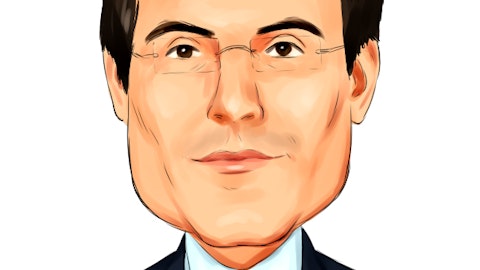Daniel Arias: Okay. That’s encouraging. Maybe just a follow-up on the AI piece, consistently solid growth there. I’m curious if you’re just still carrying a backlog in microscopy. And can you maybe just talk a little bit about lead times and order conversion this year, is the assumption that those might get extended as we move through the year or do you think maybe you can be stable relative to where we are today? Thanks.
Marc N. Casper: Yes. So when I think about the performance of our Analytical Instruments business with double-digit growth for the full year, it’s awesome. Really a tremendous year. It was across all three businesses. The backlog that we carried into the beginning of 2023, those things largely cleared in the first half of 2023. So we’re at — we’ve been normal lead times, normal shipping times really for about six months now in terms of that already. So we’re kind of in a normal spot. And yeah, there won’t be the repeat of the unwind of the pandemic impacts on the supply chain. The business is positioned for a good year and there’s a high demand for the breakthrough technologies, whether it’s in electron microscopy, or semiconductor, material science, life sciences or the Astral, right, [indiscernible] just incredible demand for those technologies. So we’re excited for the upcoming year and the future of that business.
Operator: Thank you. The next question today comes from the line of Derik De Bruin from Bank of America. Please go ahead. Your line is now open.
Derik De Bruin: Hi, good morning everyone.
Marc N. Casper: Good morning Derik.
Derik De Bruin: So Marc, I’m just sort of curious, last quarter you were talking about 1% core growth when you were sort of looking at your initial framework for 2024. If I heard you correctly, now it’s plus or minus 1%. It didn’t seem like Q4 got a lot worse in anything. So what — sort of what’s changed, are you more conservative on the PPD in these businesses, are you more conservative on just tough comps, I’m just sort of curious, what’s embedded now in this like more conservative outlook?
Marc N. Casper: Stephen, why don’t you…
Stephen Williamson: Yes. Let me provide some context on the guidance, kind of step back on that and then — and hopefully help frame your question. So we provided an early framing for 2024 on our last call, and we had the insight on how Q4 played out and have completed our detailed planning work with our businesses. Through that process, our view on the market outlook has not changed significant. The guidance is not significantly different from the initial framing that we provided. It includes the latest view on FX, both rates and expected mix of revenue and cost by currency. That increased revenue from our initial framing, but no impact on operating income, which reduces our margins by 20 basis points from that initial framing.
And then from an operational standpoint, I think the only item of note that’s changed in the past three months is a discrete item in our Pharma Services business. We’re transitioning some of our sterile fill finish capacity from COVID vaccine support to GLP-1 support. Would have been expecting to recognize an upfront fee in Q1 2024. Now the accounting is finalized, we expect to recognize that benefit in line with production, which actually starts in 2025. So it shifted approximately $0.20 out of Q1 2024, and that’s had some impact on — in terms of the reported core growth. And then one other comment on the guidance is that we thought it best to provide a range, not a point estimate. So things are more helpful for our investors and the range of outcomes for the year.
Now the range doesn’t encapsulate every possible scenario for the year, but it does capture the reasonably likely scenarios of how the year can play out as we see it today. And the range is about $1 billion to a revenue and $1.05 of adjusted EPS, which I think is appropriate given the scale of the company. But hopefully, it kind of tees up kind of the framing for the guide.
Derik De Bruin: Okay. And a little bit more, how should we sort of think about the segment margins as we go through, I mean, I’m just sort of looking — I mean you’ve seen really good progress in LSS, and it may seem a good progress in your margins, expansion of margins across all of them. But I’m just sort of thinking about how should we think about LPS and given where you were in the — is that 14% margin range that we’re seeing for the full year, is that sort of sustainable, does that fall back next year, I’m just trying to figure out where the margin hit is on given relative to what our expectations were?
Stephen Williamson: In terms of the margin profile for the — we finished the year at exactly where we guided to for the full year for our margin profile for the company. And I think some of the changes in terms of Q4 versus between the segments, I don’t think everyone quite understood the phasing of our revenue within lab products and biopharma services. So when I see some of the pre-call notes, this is, I think, a little bit different in terms of what some expectations. But from our expectations internally, Q4 played out as we’d expected. And then from margins going forward, I think the margin profile that we have today, I’m not calling a significant difference in margin profile going forward into next year. And I think where we are on landing point on margins for the segments is probably a good starting point for the — to think about for the year ahead.
Derik De Bruin: Okay, thank you.
Operator: The next question today comes from the line of Doug Schenkel from Wolfe Research. Please go ahead. Your line is now open.
Douglas Schenkel: Alright, good morning everybody. Thanks for taking the questions.
Marc N. Casper: Good morning Doug, welcome back.





